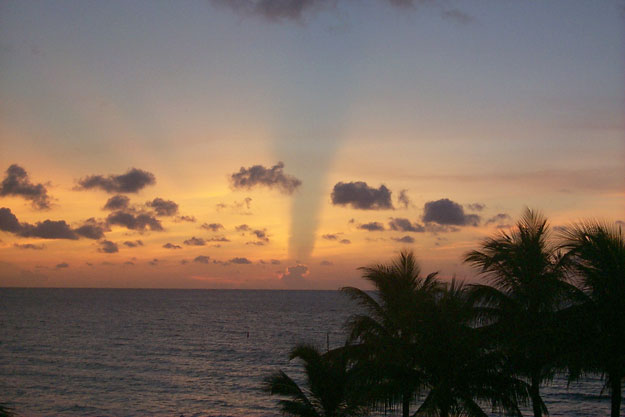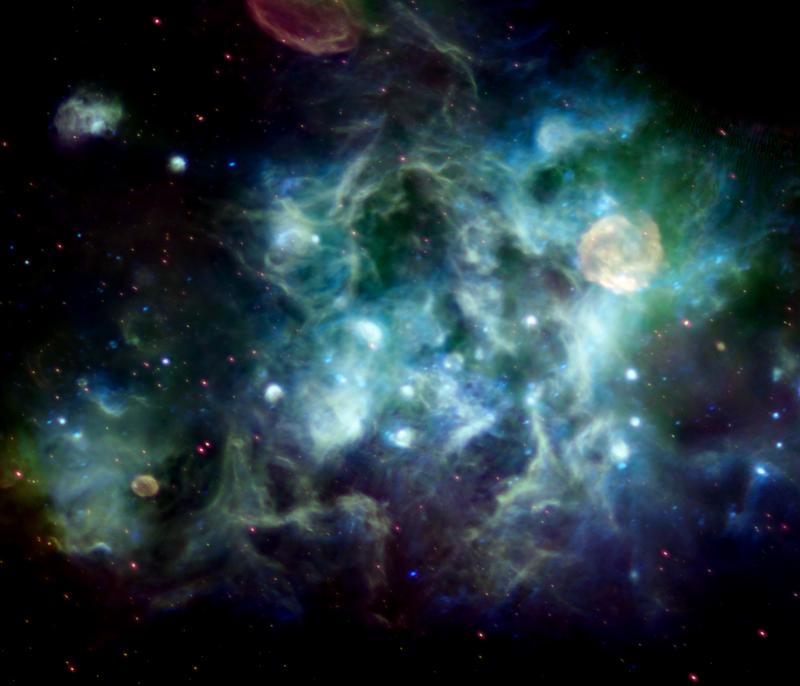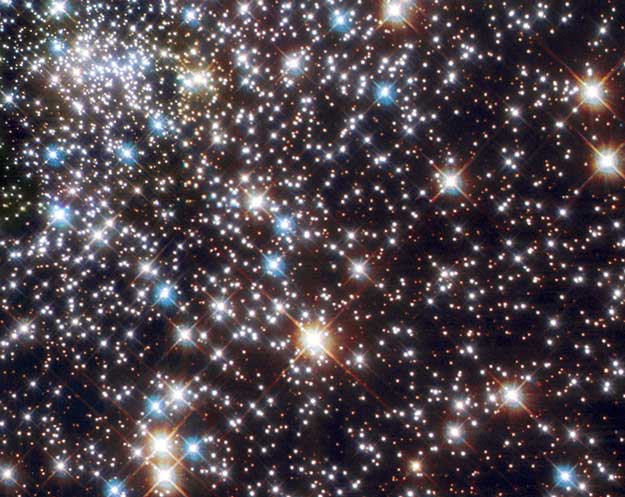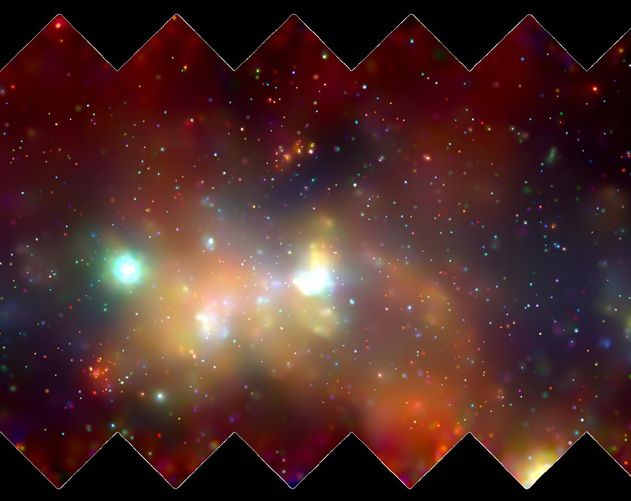Earth, Moon, Sun & Stars
Most pics courtesy of NASA
Mysterious Black Water in Florida Bay


Explanation: What is causing the water in Florida Bay to turn black? The mysterious black color could be seen as early as last December in images taken by the SeaWIFS instrument on board the Earth-orbiting SeaStar satellite. During the darkest period in February, when the above image was taken, visibility in the usually transparent/turquoise water dropped below three meters. Samples have been taken and are currently being analyzed. Early tests show the black water has normal salinity and oxygen and might be an unusual nontoxic algae bloom. Whatever the cause, the black water has real ecological and economic consequences, as normally abundant fish are completely absent. More recent SeaWIFS images show the black water to be breaking up into smaller pockets.

Explanation: Here are the true colors of planet Earth. Blue oceans dominate our world, while areas of green forest, brown mountains, tan desert, and white ice are also prominent. Oceans appear blue not only because water itself is blue but also because seawater frequently scatters light from a blue sky. Forests appear green because they contain chlorophyll, a pigment that preferentially absorbs red light. The above image is a composite generated predominantly with data from Moderate Resolution Imaging Spectroradiometer (MODIS), an instrument mounted on the Terra satellite that has orbited Earth since 1999 December. Sub-areas were imaged only when experiencing cloud-free daylight when it occurred from June through September 2001. The Earth looks much different at night.

Explanation: What could cause a ray of dark? Such a ray was caught in spectacular fashion above the Florida Everglades two years ago. The cause is something surprisingly familiar: a shadow. The gold-tinged cloud near the horizon blocks sunlight from reflecting off air behind the cloud, making that column of air appear unusually dark. Cloud shadows can be thought of as the inverse of the more commonly highlighted crepuscular rays, where sunlight pours though cloud holes. Another seemingly opposite phenomenon, a sun pillar, involves small ice crystals floating high in the atmosphere.

Explanation: Do you recognize the Earth's Moon when you see it? The crazy, patchwork appearance of the false-color image makes this almost full view of the Moon's familiar near side look very strange. The Sea of Tranquillity (Mare Tranquillitatis) is the bright blue area at right, the Ocean of Storms (Oceanus Procellarum) is the extensive blue and orange area on the left, and white lines radiate from the crater Tycho at bottom center. Recorded in 1992 by the Galileo spacecraft enroute to Jupiter, the picture is a mosaic of 15 images taken through three color filters. The image data were combined in an exaggerated color scheme to emphasize composition differences - blue hues reveal titanium rich areas while orange and purple colors show regions relatively poor in titanium and iron. Multicolor images exploring the Moon's global surface composition were made in 1994 by the Clementine spacecraft.

Explanation: Taken yesterday from the SOHO spacecraft, this false-color image shows the active Sun near the March Equinox, the beginning of Autumn in the south and Spring in the northern hemisphere. Recorded in a band of extreme ultraviolet light emitted by highly ionized iron atoms, the Sun's upper atmosphere or solar corona shines with an array of active regions and plasma loops suspended in magnetic fields. The bright coronal structures and loops seen here have temperatures of about 1.5 million kelvins. By chance, the Sun's earth-facing side also seems to be marked with a twisting complex of dark filament channels shaped like a giant "S". Filaments represent relatively (!) cool material in the corona which show up as prominences when seen at the Sun's edge. For planet Earth, recent solar activity has made auroral displays likely around this year's March Equinox.

Explanation: Shells of ancient supernovas, cocoons surrounding newborn stars, and specks from distant quasars highlight this tremendous vista toward the constellation of Cygnus. The representative color image covers about 10 degrees across on the sky but is only a small part of the Canadian Galactic Plane Survey in radio light. Diffuse bands of ionized gas flow though a dominating region of star formation, located about 6000 light-years away. Two prominent supernova shells visible include the brown globule on the lower left and the white bumpy sphere on the upper right. To the left of the brown globule is the entire North America Nebula. Prominent stellar cocoons are visible throughout the image as bright white knots. Some of these stars will likely generate future supernova shells. Far in the distance, visible here as only red dots, quasars glow.

Explanation: One of these stars is blinking. This star, a member of globular cluster NGC 6397, is noteworthy not just because it blinks, but because it blinks so fast and because its companion star is so atypical. Speculation holds that this might be a neutron star spun up to a rate of 274 rotations each second by the bloated red star it orbits. Matter gravitationally pulled from the bloated star likely orbits the millisecond pulsar, making it spin faster when it crashes onto the surface. The odd system might have resulted when the neutron star captured a normal star after a near collision near the globular cluster's dense center. Other collisions near the center of NGC 6397 are thought to have produced other oddities -- blue straggler stars. The Hubble Space Telescope took the above image of the colorful globular cluster.

Explanation: If you had x-ray vision, the center regions of our Galaxy would not be hidden from view by immense cosmic dust clouds opaque to visible light. Instead, the Milky Way toward Sagittarius might look something like this stunning mosaic of images from the orbiting Chandra Observatory. Pleasing to look at, the gorgeous false-color representation of the x-ray data shows high energy x-rays in blue, medium energies in green, and low energies in red. Hundreds of white dwarf stars, neutron stars, and black holes immersed in a fog of multimillion-degree gas are included in the x-ray vista. Within the white patch at the image center lies the Galaxy's central supermassive black hole. Chandra's sharp x-ray vision will likely lead to a new appreciation of our Milky Way's most active neighborhood and has already indicated that the hot gas itself may have a temperature of a mere 10 million degrees Celsius instead of 100 million degrees as previously thought. The full mosaic is composed of 30 separate images and covers a 900 by 400 light-year swath at the galactic center.
|